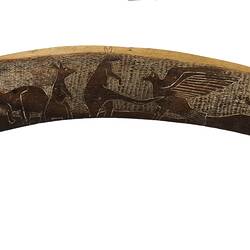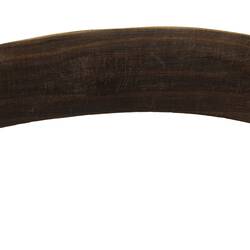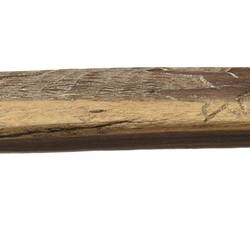Summary
The great Rainbow Serpent Wanampi shaped the landscape featured on this beautifully carved kali (boomerang). Wanampi created the rolling hills, the caves and the lakes on his journey towards the ocean from the red spinifex country in the north.
The scene shows a Walawuru (Wedge-tailed Eagle) facing a mob of Malu (Red Kangaroo). The largest bird of prey, with a wingspan that can reach 2.3 metres, this opportunistic raptor generally feeds on rabbits, wallabies and small kangaroos. When these are scarce, it feeds on various ground- and swamp-dwelling birds and reptiles.
Local Name
Kali
Physical Description
Curved asymmetrical boomerang with tapered ends. Plano-convex in cross section. Anterior surface is decorated with an incised pattern of kangaroos and eagle against an outback scene. Incised lines have been infilled with white ochre. Posterior side is smooth and undecorated.
Significance
Regrettably the name of the Pitjantjatjara man who carved this remarkable story from his Country was not recorded when the kali came into the Museum collection. He is from the Yalata community, which identifies as southern Anangu (people from the Central and Western Deserts) and speaks a Pitjantjatjara dialect.
His people came from the desert in the north and north-west and were removed from their lands in the late 19th century and again in the 1950s when nuclear tests were conducted on their ancestral lands without their knowledge or permission with devastating and long-lasting effects on both the people and their Country. The families eventually settled on a mission in coastal South Australia. Today, the Anangu live in small communities and outstations across over 103,000 square kilometres of their traditional lands. In the summer, family groups move north to attend ceremonies.
Most recently, Yalata community artists have told their story in relation to the devastating effects of nuclear testing on their Country and peoples through a sculpture which was presented to the Japanese community at Nagasaki who were also catastrophically affected by bombings. Yalata community leader Russell Bryant commented on the connection and friendship experienced as part of this cultural exchange;
'Japan and Yalata people, Maralinga people, they both got same stories'.
Russell Bryant, 2016.
References
ABC News, Maralinga Nuclear Test Survivors Connect with Japanese Bombing Survivors, 2016, Viewed 23 August 2017.
More Information
-
Object/Medium
Boomerang
-
Maker
-
Cultural Groups
-
Locality
-
Object Measurements
770 mm (Length), 190 mm (Width), 20 mm (Height)
-
Classification
-
Date Made
-
Maker
-
Clan/Language Group
-
Place Made
-
Indigenous Region
-
Keywords
-
Collection Names
-
Type of item
-
Discipline
-
Category
-
Collecting Areas



